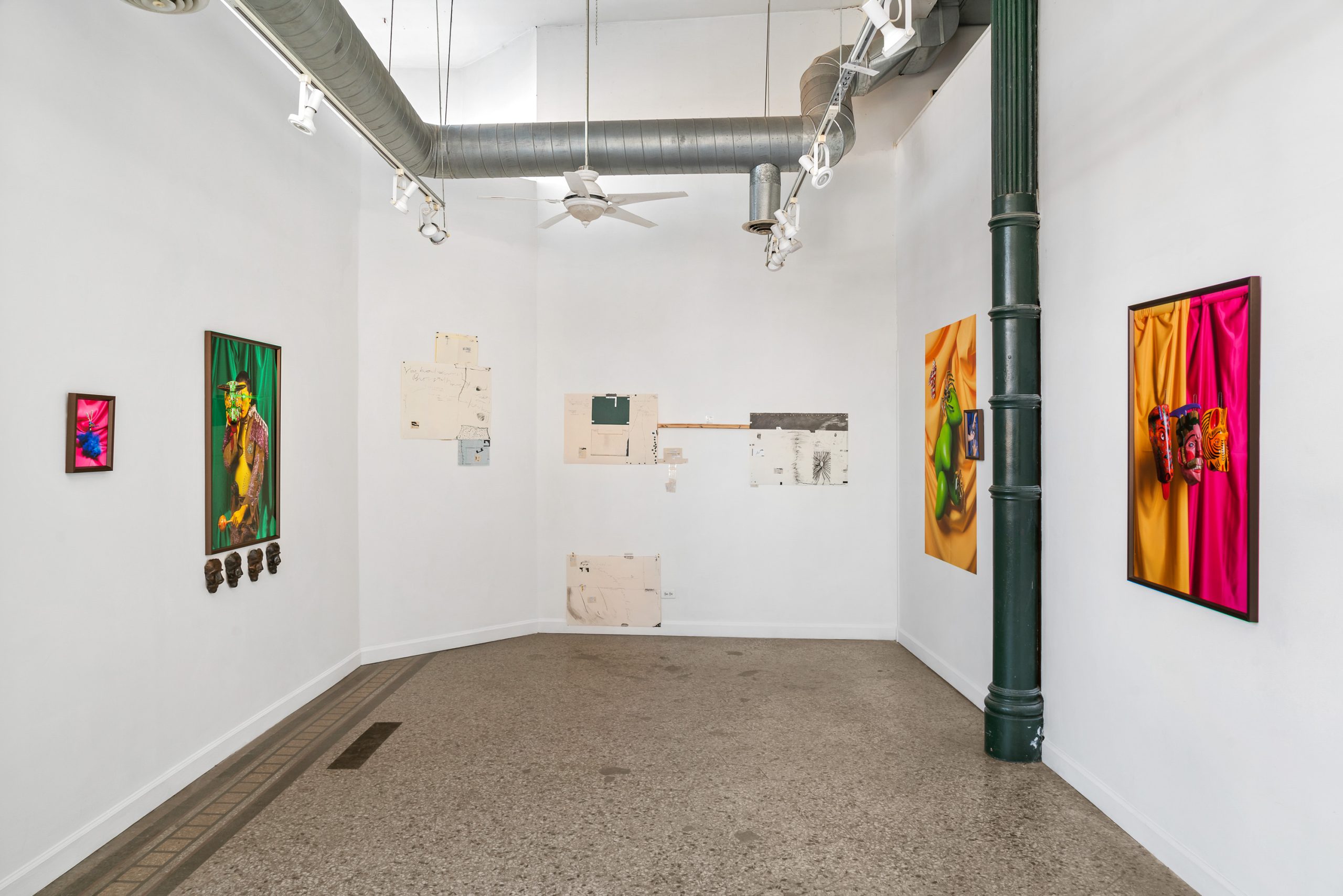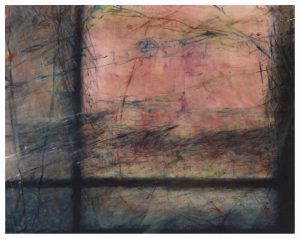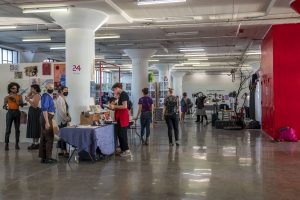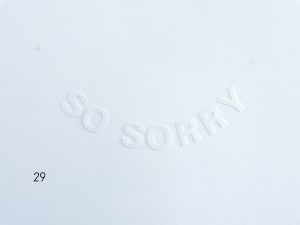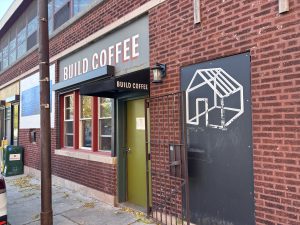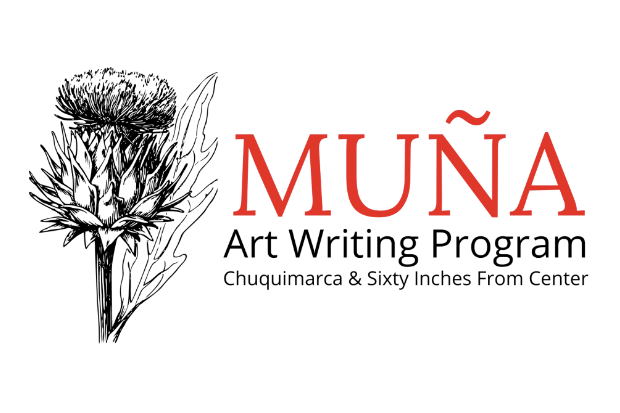
This article was developed and written as part of Muña, an art writing program providing a cohort of writers the opportunity to critically and creatively engage with art writing strategies, readings, exercises, and conversations. The program is structured for writers to develop and refine their practices through guided workshops and peer-review feedback. Its task is to stir, incubate, and pollinate shared consciousness on holistic, equitable, and attentive art writing and language practices. Muña is a program collaboration by Chuquimarca and Sixty Inches From Center.
In Roots & Culture Contemporary Art Center’s Archiving Edging: The edges of archives and to edge an archive, olivier and Martín Wannam cross-examine and tease out their shared knowledge about queer histories. The artists’ works overlap by looking at ‘anarchiving’—or, producing new and generative relationships with public records of queerness past and present. olivier is a research-based writer, artist, poet, time-traveler, speculative world-builder, and archives worker concerned with the ephemeral nature of the archive and queer theory. Wanman is an artist educator whose maximalist approach to photography, sculpture, and performance examine Guatemala’s cultural climate with focus placed on dreaming, “ for the cuir individual.” When engaging with alternative histories of sexuality, reckoning with the fragmented and ephemeral nature of the archive, which marginalizes bodies and experiences, is imperative. The state of an archive will, often, if not always, reflect the experiences of erasure befallen to its descendants.1
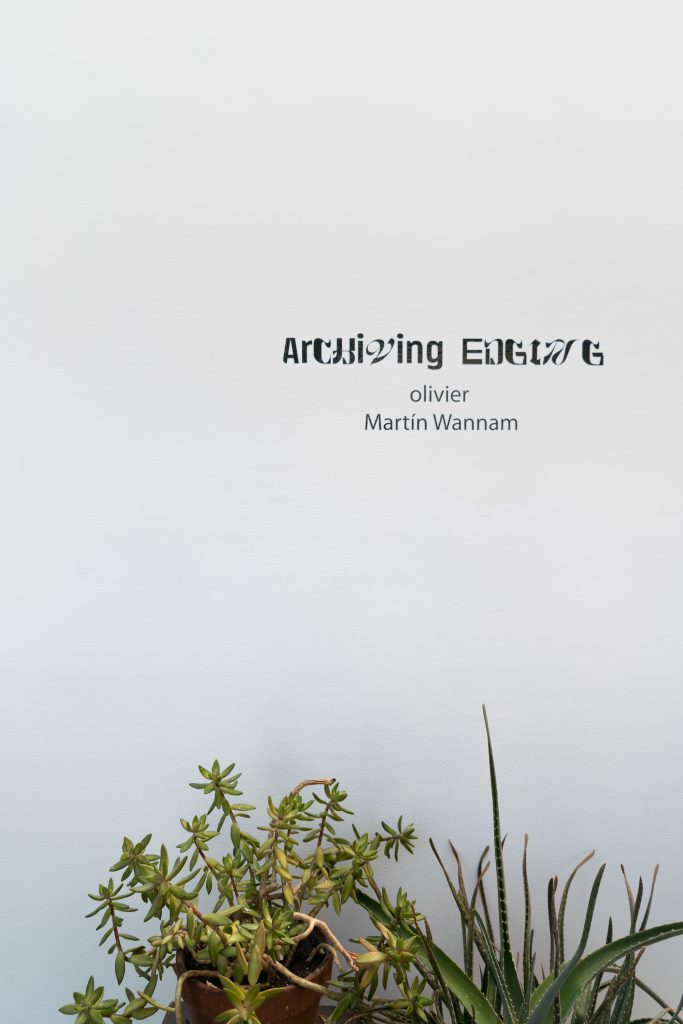
On gallery walls and atop industrial pipes the artists frame, tuck, edge, de-center, square, level, layer, and accumulate their works across the space. It reads like a spliced-up, physicalized publication. If all the works were shrunken, pasted together, folded in and out and layered, they could make an accordion zine. With that metaphor, olivier’s insertions of tiny laminated prints and Wannam’s sculptural accompaniments are akin to the too-important-to-be-deleted footnotes that a reader must scour to make sense of what’s handed to them. As I hold your hand during this walk-through, keep this imagery in mind.

“Whose bush is that?” my pool league teammate asks me, as she peers over my shoulder. What a fitting question to consider as I write about my encounter with Wanman’s first installation. Directly to the left, against the back wall of Roots & Culture’s small alcove, is a mixed-media photography installation: two photos, one large and one small, against a scenic backdrop. The small photograph (left), Cenizas de Oro, is framed by boughs of overgrown goldenrod in the foreground. Suggestions of civilization, like powerlines and edges of buildings, fade into the distance. Cenizas de Oro / Golden Ashes, reference manuscripts burnings by the Spanish in 16th-century Guatemala. With the destruction of these archives a great deal of queer—well, cuir2—histories were destroyed. The image features what looks like glittery piss in a liquor bottle, amidst a sultry, loamy brown topography. Bodily fluids, the abject, are restrained in a man-made container, prohibited from soaking, evaporating, and falling back into the local ecosystem.
Next to the burgeoning green bushes and tufts of baby’s breath, lies another bush, that of the artist Wannam. On the right is a large-scale self-portrait of the artist entitled El Venado. Set against a soft beige sateen curtain, Wannam stares. He is naked in front of the camera. His hands on his head hold lilac-toned wooden antlers. The tip of his penis edges the photograph’s border. Beyond the coy insertion of antlers, Wannam’s eyes are distorted and stretched, with either Photoshop, or some filter software. There’s a sense of strangeness and deviancy here, or lo raro, as Pedro Lemebel cites.3 Wannam positioning himself as prey references the “Baile Del Venado” (“Dance of the Deer,”) an indigenous folkloric dance where the deer is replaced by a human actor and hunted by the other dancers. Wannam evoking this imagery plays with a sense of wildness, poking fun at the colonial paradox of ‘civilized’ and ‘wild.’ He asserts that “what is understood as natural or unnatural has changed over time.”4 His works probe whether queer recognition offers access and safety to cuir people.5 The deer isn’t safer in the headlights. Moreover, who decides what is strange or natural, and how does that touch or affect those on the margins?
This idea builds to a crux of the show: where do the margins end and begin and who is writing the main text? And when it comes to waxing poetic on the notion of margins, olivier’s works deliver over, and over, and over, and don’t quite ever end. They put it succinctly, describing their sutured assemblages in the show as reveries and ruminations on “the impossibility of locating a finishing of the text as an edging practice.”
Hidden from view til you turn the corner is To be trans is to be a pessimist choosing pleasure(edge) than to standing with you in the margin(none). The artist cites this as one of their more vulnerable pieces of the show (and I cite it as didactic). The pages are laminated, layered, categorized, and suspended, everything in its right place, perhaps. Small annotations play with the borders of Stonehenge paper and extra magnets and hooks are abound. olivier pulls from Helene Cixous, Arthur Rimbaud, Jacques Derrida, and Elvis Presley. The splicing and re-imagining of found texts features innumerable quips and sentiments, many of which feel ardently esoteric, but are often equivocating placeholders all of us gays hold on to, and place ourselves within. In this work, they court the etymology and epistemology of ends and margins, asking whether it’s safe on the edge. olivier appropriates the question: “Are we fools to go where angels fear?” These feared edges are the margins, the undergrounds, the wilds, and the salacious basement party with glory holes abound.6 Does looking through the glory hole bring us glory?7 How one understands the edges of pleasure depends on their material realities.
olivier’s collaged texts cruise around corners, suspend from the ceiling, and sneak close to the floor, often getting dangerously close to the edge. Sometimes the pieces are out of reach, and the artist’s subtle scrawl often leans into illegibility. I find myself tempted, haphazardly jumping to read their notes. This impulse, well compulsion really, makes sense, for when certain things become visible it doesn’t mean they are protected.
But will the doe flit over to safety? The artists flirt and linger within these boundary lines with one another. It becomes alluring to start and never finish, flitting from work to work, building up half-understandings, an experience that many archivists experience. When we build from traces of the past, the public record will always be unfinished.8 These half-understandings are necessary to grapple with the esoteric and culturally-specific nature of each work.9 In Edging, Wannam and olivier offer the emancipatory and boundless potential of the draft, which points to the complexity of legibility and accessibility concerning the “queer” archive. The show and its parts are another buoyant entry in an ongoing anarchical process in which the art world and its counterparts find themselves implicated.
Roots & Culture Contemporary Art Center’s “Archiving Edging: The edges of archives and to edge an archive” was on view February 2nd – March 9th, 2024.
Works Cited:
1 There are a variety of texts corroborating archival erasure but Saidiya Hartman’s “Venus in Two Acts” is one of best explorations and re-frames the recovery work within a Black Feminist paradigm as ‘critical fabulation.’
2 Macarena Gomez-Barris’ “How Cuir is Queer Recognition?: A manifesto from the Sexual Underground,” in Beyond the Pink Tide: Art and Political Undercurrents in the Americas, analyzes Chilean Essayist Pedro Lemebel’s revolutionary poem and manifesto, “Hablo por mi diferencia,” / “I Speak for My Difference.” By using the term cuir, Barris writes, “I point to the specific Spanish term [cuir] for ‘queer’ that renders the specificities of the continent by locating non-normative bodies in space and time.”
3 In the same chapter, Macarena Gomez-Barris looks at his use of ‘strangeness’ when engaging with the etymology of the term cuir, criticizing the inherent whitness in the term queer, and opts for a term that recognizes the experiences of queer Black and brown folks in Latin America.
4 Jack Halberstam explores this ‘wildness,’ in Wild Things: The Disorder of Desire, 2020.
5 Throughout this essay I default to using the term ‘queer,” as an umbrella term, while acknowledging its etymology is restrictive. Further examination of the term and its implications is warranted. However, I’m building in part from bell hooks’ definition for the term that holds that, “queer’ not as being about who you’re having sex with (that can be a dimension of it); but ‘queer’ as being about the self that is at odds with everything around it and that has to invent and create and find a place to speak and to thrive and to live.”
6 This is a repeated sentiment throughout the show and references the track, “Fools Rush In (Where Angels Fear to Tread),” written by Leon Payne and popularized by Elvis Presley.
7 A girl and I had a conversion about glory holes that made it into this essay. Pleasure for the sake of pleasure is beautiful.
8 The Western perceptions of archives inherently privilege white supremacist heteropatriarchy and forms of recordkeeping, meaning that forms of recordkeeping, especially oral histories are not prioritized or referenced at the same frequency.
9 In the case of some of olivier’s works, descriptions are also in Cantonese, making it opaque to non-Cantonese speakers. To all my lovers: (gesture to front stage/introduction). It’s description reads:
戀愛是無字天書 只靠愛人來記住 要用靈魂和心血 揭到最好的那端
戀愛是無字天書 留下詩篇千萬段 on Stonehenge paper
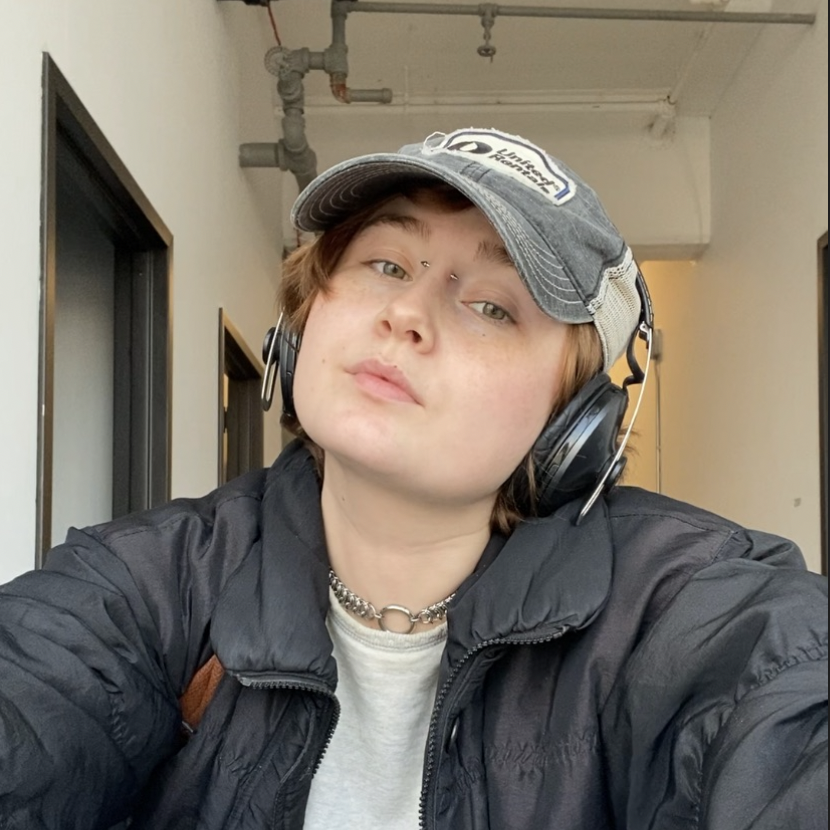
About the author: Joan Roach is a Chicago-based educator, curator, arts writer, and poet. Their writing and curatorial practices focus on sculptural, textual, and performance-based art concerned with how social space is conceptualized, created, and restricted. They write from a phenomenological perspective to encourage readers to critically examine their relationship with the material world. After working as the publication editor for LVL3, a curatorial resident for Chicago Artist’s Coalition, and then a curatorial assistant for Johalla Projects, they elected to focus their career on arts writing and publishing, while teaching Art History at the Chicago High School for the Arts. Most recently, they’ve begun producing an art journal titled Slit that will debut in spring 2024.
